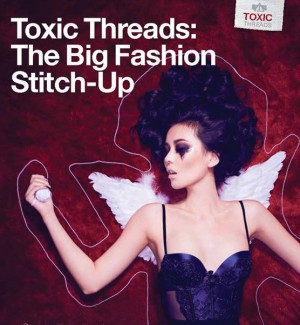Are Our Clothes Toxic? Marci Zaroff, Eco Fashion Pioneer, weighs in!
Did you know that:
- A recent study of 20 name brands revealed that clothing companies like Calvin Klein, Levi’s and Zara, contain traces of hazardous, potentially cancer-causing chemicals?
- More than 8,000 toxic chemicals are used to turn raw materials into textiles, many of which are carcinogenic, corrosive or include biologically-modifying reagents?
- Producing one pair of jeans requires more than 1,800 gallons of water, nearly a pound of water?
- Bamboo is actually a synthetic fiber that some companies market to appear more environmentally friendly?
- The average U.S. citizen throws away 68 pounds of clothing per year, with 2.5 billion pounds of post-consumer textile waste ending up in our landfills annually?
- 20 percent of the world’s industrial fresh water pollution comes from textile treatment & dyeing?
- More than one trillion kilowatt hours are used annually in the global textile industry, representing more than 10% of the world’s carbon footprint?
- Every half hour, a cotton farmer in India is committing suicide by drinking the very pesticides that he uses on his crops?
I certainly didn’t until recently, and as I leaned more, I started to feel disillusioned with an industry that I began to realize was not just exploitative in its labor practices, but environmentally toxic. To help me navigate through the overwhelming amount of information out there on the topic, I talked with Marci Zaroff, a true trailblazer in the sustainable fiber and fashion industry. In 1995, Zaroff coined the term ‘Eco Fashion,’ as a way to fuse the glamorous world of fashion with environmental and social responsibility, and that phrase has now turned into a six billion dollar industry. Zaroff has also helped to define and draft the Global Organic Textile Standard (GOTS) and the first USA Fair Trade certification for textiles with Fair Trade USA. Currently expanding her pioneering Eco Fashion lifestyle brand “Under the Canopy,” while working on her upcoming sustainable fashion brand FASE, as well as the documentary Thread, which she hopes will educate citizens on the environmental and human impacts of fashion & textile production, she is a true wealth of knowledge on the subject. For this first part of a three-part series, I wanted to focus more on the toxic environmental impact that the textile industry has on the environment and on ourselves before turning to the human costs tomorrow. On Friday, December 7, we will discuss how to gauge which companies are truly transparent in their sustainable practices and which ones are just greenwashing, and how to best move forward with the movement.
Nadia: So could you tell us a bit more about what motivated your passion to educate others about environmental issues and “Eco-Fashion?”
Marci: I am passionate about education, innovation, building community and connecting humanity. I have always felt a deep sense of global responsibility, and the foundation of many of my efforts over the last two decades is built under the notion that we are all interconnected, that we are all part of the same eco-system. The first eco-fashion brand that I started in 1996 is called “Under the Canopy,” and the premise is that we all live under the canopy of the planet’s eco-system together. The Native American philosophy is to protect our canopy, to protect life, for generations, which can best be expressed through the saying, “We do not inherit the land from our ancestors; we borrow it from our children.” If you’ve ever been to any of the rainforests in the world, you’d know that the canopy is the top layer of the rainforest. So there is more life under the canopy of the earth’s rainforests than anywhere in the world, and it is that very life, and those eco-systems, that provide the oxygen that we all depend on to exist.
Who knew that something so cute could be so toxic?
So going back over the past 20 years, as I worked with the natural food and beauty industries, I gained a deeper understanding of the relationship within agriculture, and that you can’t support one part of the equation without the other. In agriculture, all of the crops that grow, especially if you are growing organically, they’re very much interconnected. One of the main foundations of organic agriculture is crop rotation, and one of the main crops that are rotated is cotton. 60 percent of a cotton plant ends up going into the food chain—for oils, for bread products. If you read the back of many packaged products on the market today, they will have cottonseed oil as an ingredient. As I started to learn about the connection between food and fiber and the harmful chemicals used at all stages of the textile industry, I wanted to pull the curtain back, shift the paradigm, and offer consumers more sustainable choices. I was disillusioned when I discovered that the manufacturing processes of conventional textiles are extraordinarily toxic. When I started to learn the impact that conventional textiles were having, both from the fiber standpoint and the manufacturing standpoint, I coined the term ‘Eco-Fashion’ because I wanted to fuse those two very dichotomous worlds together— one being ecology, eco-systems, and our connection with the environment, the other being fashion. My mission was to revolutionize the fashion industry and demonstrate that those two worlds were not mutually exclusive.
Nadia: It was so surprising to learn how toxic cotton was. I mean, I had always thought of cotton as a ‘natural’ fiber!
 A model wearing an oxygen mask, walks along a
A model wearing an oxygen mask, walks along a
make-shift catwalk during a fashion show
organized by environmental group Greenpeace
titled ‘Toxic Threads – The Big Fashion Stitch-Up’,
in Beijing November 20, 2012.
(photo courtesy of REUTERS/David Gray)
Marci: It’s not. In fact, conventional cotton is one of the world’s leading sources of air and water pollution!Even though conventional cotton represents less that 3% of the world’s agriculture, it uses as much as 25% of the most harmful insecticides, and up to 10% of the most toxic pesticides to grow it! It is also incredibly wasteful in the amount of water that it uses—100 gallons to make one pound, and almost 3% of the world’s yearly water usage. In fact, not only does it take 700 gallons of fresh water to make just one cotton T-short, but in 2009, the world used three trillion gallons of fresh water to produce 60 billion kilograms of cotton fabric. Furthermore, other harsh chemicals, such as chlorine bleaches and formaldehyde, are used in conventional cotton production processes.
Victoria’s Secret, named in Greenpeace’s
Study for containing chemical residue in
their clothing, is parodied in an ad.
Nadia: Well, and I can’t believe the chemicals that are released to make our clothes! I recently read in Elizabeth Cline’s book Overdressedthat making synthetic fibers such as rayon, viscose, acetate, cupro, and even bamboo requires treating substances like wood pulp and scrap cotton with toxic chemicals. And then I learned from this recent study released by Greenpeace, which tested 20 brands such as Calvin Klein, Levi’s Victoria’s Secret and Zara, that several of the hazardous chemicals found in the garments contained toxic phthalates and even cancer-causing amines from the use of certain dyes!
So what is different about organic cotton?
Marci:In order to have organic food crops, you have to nurture and build the soil, versus conventional agriculture where you are depleting and destroying the soil via poisonous sprays and monocropping, which is when you grow a single crop year after year on the same land. These healthier soils make better use of water inputs and are more resilient in drought conditions. Also, when you eliminate synthetic pesticides and fertilizers, the water pollution impact from organic cotton is 98% less than non-organic cotton production, and it produces 94% less greenhouse gas emissions.
Nadia: So can you point us to more sustainable fabrics to look for?
Marci:Tencel from Lenzing, which I am rebranding as ‘ECOlyptus,’ is the cellulose that’s extracted from the eucalyptus plant, grown without water on non-arable land, broken down by a non-toxic, recycled detergent, and manufactured in an efficient closed-loop system that takes minimal energy. It feels like silk and is three times stronger than cotton. Recycled Poly is a great alternative to conventional polyester, which is made with fossil fuels, using an enormous amount of energy.
Nadia: What is recycled poly made with?
Marci: Recycled Poly takes recycled plastic bottles out of landfills and turns them into fiber. There’s a recycled poly yarn fabric called Repreve made by a company in North Carolina called Unifi. In 2012, this company kept 900 million plastic bottles out of landfills in one year! It’s really amazing.
Nadia:Do you have any online suggestions for good eco-fashion information and retailers?
Marci: Eco Fashion World, Ecouterre, ECOfabulous, Fashioning Change, Inhabitat and Magnifecoare just a few of the resources out there!
Stay tuned for the second part of our series, where Marci will provide more information on the human impact behind the conventional textile manufacturing process!
How cotton production has eradicated the Aral Sea and poisoned its workers:
Full link here: http://listengirlfriends.wordpress.com/2012/12/05/are-our-clothes-t...
Welcome to
Ethical Fashion SOURCE Network
© 2025 Created by Ethical Fashion Forum.
Powered by
![]()



You need to be a member of Ethical Fashion SOURCE Network to add comments!
Join Ethical Fashion SOURCE Network